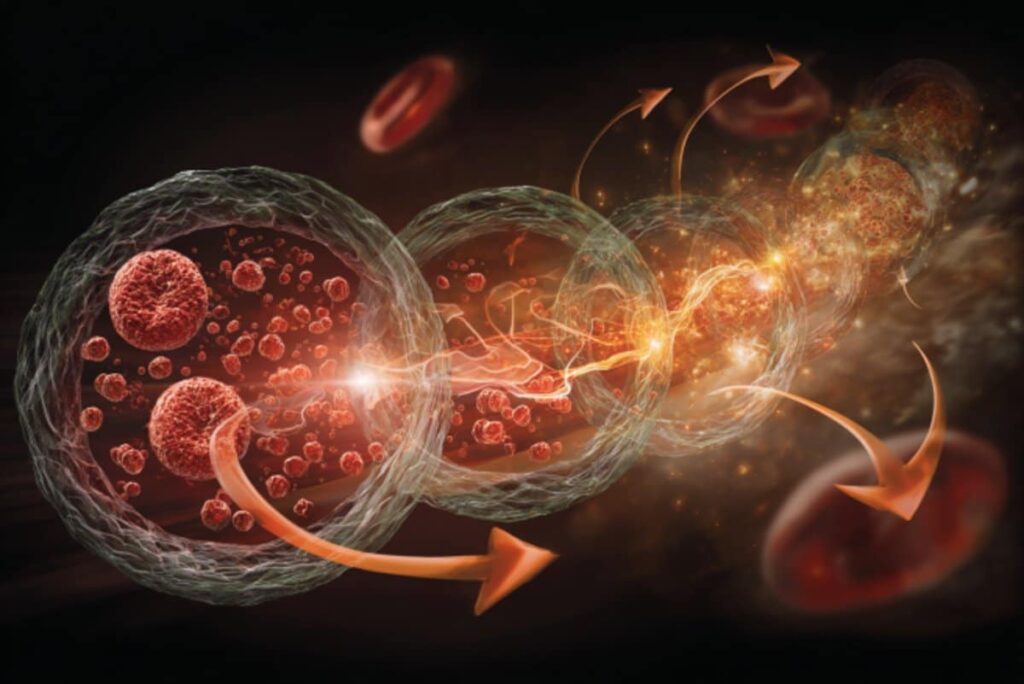
New research from Korea University College of Medicine has unveiled a groundbreaking discovery: aging is not merely a localized cellular process but can propagate throughout the body via the bloodstream. This revelation centers around a redox-sensitive protein known as ReHMGB1, which is secreted by senescent cells and has been found to trigger aging features in distant tissues, impairing regeneration and muscle function.
The study, led by Professor Ok Hee Jeon, demonstrated that blocking ReHMGB1 with antibodies in mice reduced cellular aging markers and improved physical performance post-injury. These findings not only identify a key molecular messenger of systemic aging but also offer a promising therapeutic target to slow or reverse age-related decline.
The Role of ReHMGB1 in Systemic Aging
For the first time, a Korean research team has discovered how cellular aging can spread systemically through the bloodstream. Professor Jeon’s research group at the Department of Convergence Medicine identified High Mobility Group Box 1 (HMGB1) as a critical extracellular senescence-associated secretory phenotype (SASP) factor. This protein plays a pivotal role in transmitting senescence from aging cells to distant tissues.
Senescent cells are known to secrete pro-inflammatory factors and signaling molecules, collectively known as SASP, which induce paracrine senescence in surrounding cells. Over time, these senescent cells accumulate in various tissues, impairing regenerative capacity and contributing to tissue dysfunction. However, the mechanism by which senescence spreads systemically remained unclear until now.
Scientific Insights and Methodology
The study, published in the journal Metabolism – Clinical and Experimental, offers the first evidence that reduced HMGB1 (ReHMGB1), a redox-sensitive isoform of HMGB1, circulates through the bloodstream and induces senescence in remote tissues. Using both in vitro and in vivo models, the researchers demonstrated that extracellular ReHMGB1, but not its oxidized form (OxHMGB1), robustly induces senescence-like features in multiple human cell types, including fibroblasts, renal epithelial cells, and skeletal muscle cells.
Mice treated systemically with ReHMGB1 exhibited elevated senescence markers, increased SASP factor expression, and impaired muscle function. Furthermore, in a muscle injury model in middle-aged mice, administration of anti-HMGB1 antibodies not only reduced senescence markers but also enhanced muscle regeneration and improved physical performance.
Therapeutic Potential and Future Implications
These findings highlight the therapeutic potential of targeting extracellular HMGB1 to reverse or mitigate age-related tissue dysfunction. “This study reveals that aging signals are not confined to individual cells but can be systemically transmitted via the blood, with ReHMGB1 acting as a key driver,” said Professor Jeon. “By blocking this pathway, we were able to restore tissue regenerative capacity, suggesting a promising strategy to treat aging-related diseases.”
The research was supported by the Myokine Research Center and the Mid-sized Research Support Project of the Ministry of Science and ICT. It was conducted in collaboration with internationally recognized experts in aging biology, including Professor Irina Conboy of UC Berkeley and Professor Christopher Wiley of Tufts University.
Broader Context and Historical Parallels
The discovery of ReHMGB1’s role in systemic aging represents a significant advancement in understanding the biological processes of aging. Historically, aging has been perceived as an inevitable, localized decline in cellular function. However, this study challenges that notion, suggesting that aging can be influenced by systemic factors that circulate throughout the body.
Previous research has focused on the role of senescent cells and their localized effects on tissues. This new understanding of systemic aging opens the door to novel therapeutic strategies that could potentially delay or reverse the aging process by targeting circulating factors like ReHMGB1.
Expert Opinions and Future Research Directions
Experts in the field of aging biology have lauded the study for its innovative approach and potential implications. According to Dr. Irina Conboy, a collaborator on the study, “The identification of ReHMGB1 as a systemic driver of aging provides a new target for interventions aimed at extending healthspan and lifespan.”
Future research will likely focus on further elucidating the pathways by which ReHMGB1 influences aging and exploring the potential of ReHMGB1 inhibitors in clinical settings. The implications of such research could be profound, offering new hope for combating age-related diseases and improving quality of life for the aging population.
As the global population continues to age, the demand for effective anti-aging therapies is increasing. This study marks a pivotal step forward in the quest to understand and ultimately control the aging process, potentially transforming the landscape of healthcare and aging research.







